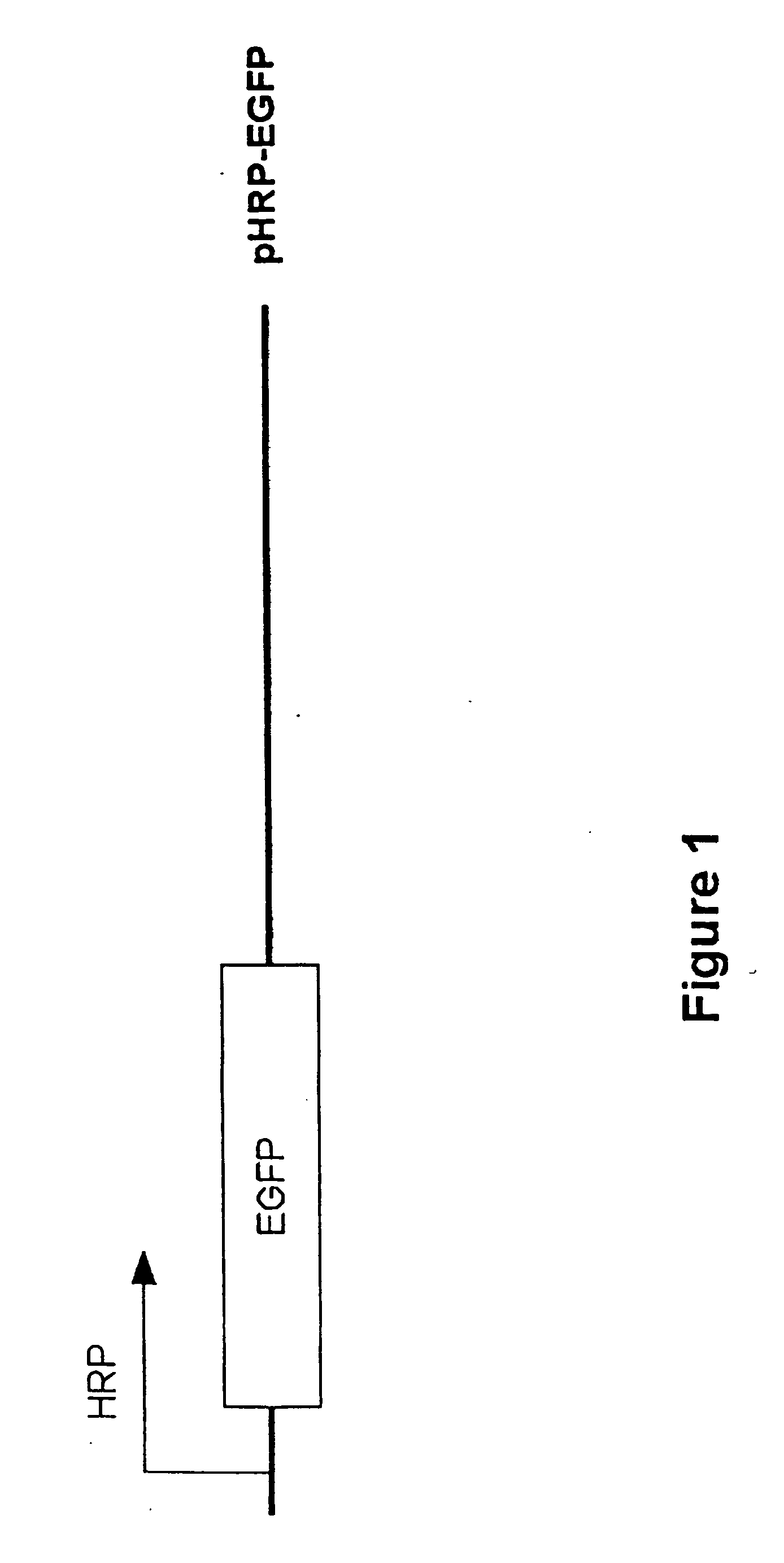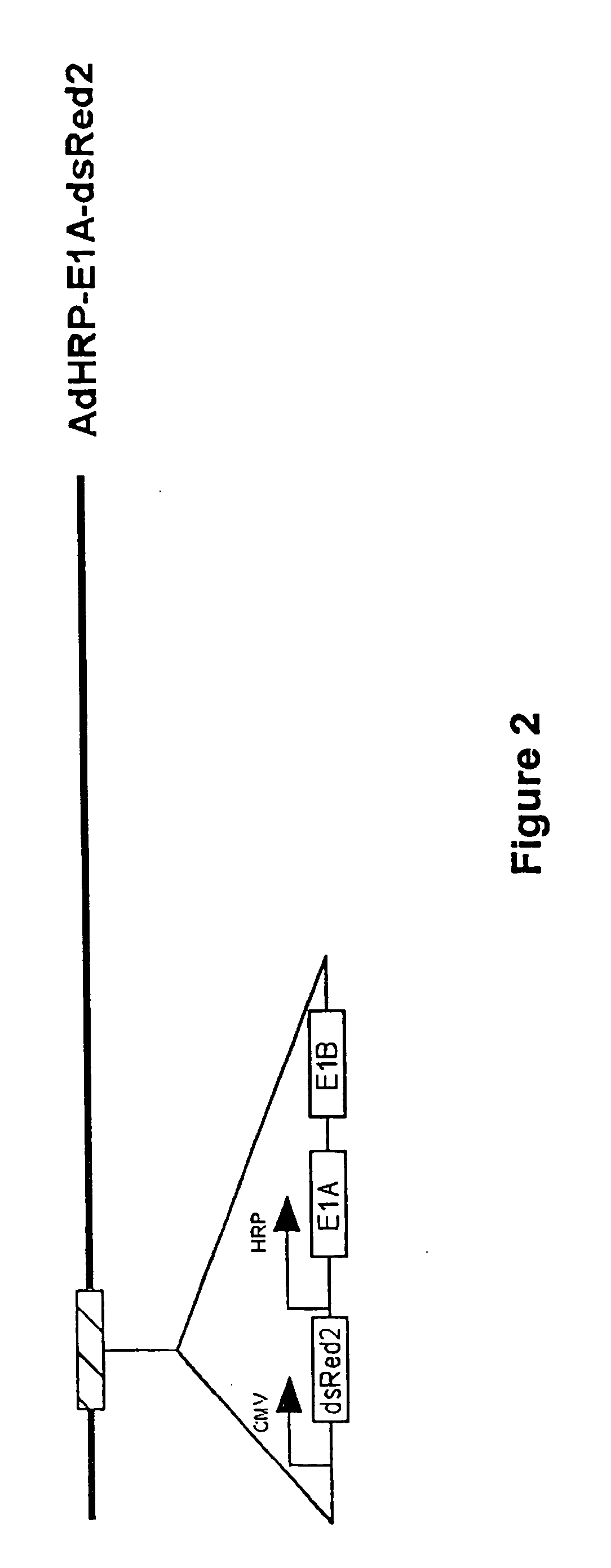Targeted tumor therapy by use of recombinant adenovirus vectors that selectively replicate in hypoxic regions of tumors
a technology of adenovirus and adenovirus gene, which is applied in the direction of viruses, drug compositions, peptides, etc., can solve the problems of cancer recurrence, virtually impossible for surgeons to remove all cancerous cells, and each has its limitations
- Summary
- Abstract
- Description
- Claims
- Application Information
AI Technical Summary
Benefits of technology
Problems solved by technology
Method used
Image
Examples
example 1
In Vitro Expression of EGFP in Cells Exposed to Hypoxia
[0184] A promoter based on the HIF-1 binding elements in the VEGF promoter was constructed. The hypoxia responsive promoter (HRP) comprises 5 tandem copies of the HRE from the human VEGF promoter linked to the minimal promoter from cytomegalovirus (CMV). In order to test the activity of this promoter, a plasmid, depicted in FIG. 1, was constructed in which the HRP controlled the expression of the enhanced green fluorescence protein (EGFP) gene. The HRP-EGFP construct was used to establish stable sublines from two tumor cell lines: HCT116, a human colon carcinoma cell line; and 4T1, a murine mammary adenocarcinoma. Cells from stably transduced sublines exposed to hypoxic conditions (with oxygen tension at 0.5 to 1.5%), showed robust expression of EGFP 24 hours after incubation.
example 2
HRP-Driven EGFP Expression in Subcutaneous Tumors
[0185] Tumors were established by injecting 105-106 cells into mice subcutaneously. The injected cells were 4T1 cells stably transduced with a construct (HRP-EGFP; see FIG. 1) comprising an artificial hypoxia responsive promoter controlling the expression of the EGFP gene. Tumors were allowed to grow to approximately 5-8 mm in diameter. Right before excising the tumor and sacrificing the mice, mice were injected with pimonidazole intraperitoneally. Pimonidazole staining is a standard method for identifying hypoxic regions within tumors (Raleigh et al., 1998). Frozen sections of the tumors were then stained with an anti-pimonidazole antibody and observed under a fluorescence microscope. The EGFP expression patterns from the same sections were also observed. Concordant patterns of EGFP expression and pimonidazole staining were observed for each section, confirming the suitability of the HRP-EGFP reporter in reporting hypoxic tumor regi...
example 3
In Vitro Replication of Conditionally Replication Competent Adenovirus Vectors
[0186] An adenovirus vector comprising the adenovirus E1A gene under the control of the HRP promoter was constructed (AdHRP-E1A-dsRed2; see FIG. 2). A reporter gene encoding a red fluorescent protein (dsRed2) was engineered into the vector to facilitate tracing of virus infection and replication. This vector was then tested in the HCT116 human colon carcinoma cell line. Hypoxia led to active replication of this virus vector. Fluorescence microscopy demonstrated significantly more virus replication and infection in the cells exposed to hypoxia. When measured by flow cytometry, the differential in dsRed2 expression was at least 100 fold, which was confirmed by plaque forming assays. Western blot analysis of E1A protein showed that E1A is expressed at a significant level only in cells that were subjected to hypoxic conditions.
PUM
| Property | Measurement | Unit |
|---|---|---|
| Immunostimulation | aaaaa | aaaaa |
| Responsivity | aaaaa | aaaaa |
| Pharmaceutically acceptable | aaaaa | aaaaa |
Abstract
Description
Claims
Application Information
 Login to View More
Login to View More - R&D
- Intellectual Property
- Life Sciences
- Materials
- Tech Scout
- Unparalleled Data Quality
- Higher Quality Content
- 60% Fewer Hallucinations
Browse by: Latest US Patents, China's latest patents, Technical Efficacy Thesaurus, Application Domain, Technology Topic, Popular Technical Reports.
© 2025 PatSnap. All rights reserved.Legal|Privacy policy|Modern Slavery Act Transparency Statement|Sitemap|About US| Contact US: help@patsnap.com



